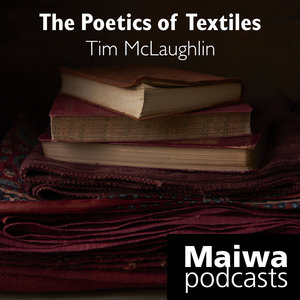October 19th was the final lecture of the 2016 series. Traditionally the last lecture is the Threads lecture - a chance to talk about the work of the Maiwa Foundation and to raise money for the Foundation's work.
The evening concluded a trio of events about the Banjara. It followed the exhibition and book launch with a behind the scenes "Making of the textiles of the Banjara." Charllotte and Tim outlined the history of this group of semi-nomadic people, looked at stitches and motifs, and showed video from over fourteen years of visiting the Banjara.
The evening was introduced by Sophena Kwon, who gave the audience some intimate details and little know facts about the presenters. We are happy to reproduce it in full here.
I have the great privilege to introduce two of
my favourite people on this planet.
Charllotte Kwon, my mom and Tim McLaughlin.
Now, I’m not going to talk about the Banjara… or
the many trips to India these two have made together to research and photograph
for the book. I’m not going to
tell you about the latest review the book had in this month’s issue of The World of Interiors or that the book has been distributed world wide and was featured
on the ‘Staff Picks’ table in our favourite bookstore in London called Daunts
Books.
Instead, I would like to use this great privilege to shed some light on a few lesser known facts about these two.
Some may not know that my mom started out in her early 20’s getting her journeyman’s ticket in printing and ran a Heidelberg press for Hemlock Printers. She was the only woman in the workshop and was nicknamed Charlie. 8 years into this profession she got blood poisoning from the leads and heavy toxins in the printing inks. The blood transfusion and a realization that she was not going to return to the profession of printing was the catalyst that began her journey in search for alternative, gentler, more sustainable ways to achieve colour and changed her medium from paper to fabric. Now she has almost 40 years of Natural dyes experience behind her. Natural Dye is one of the major building blocks that Maiwa stands on and her fascination with natural colour has taken her all around the world in search of dye recipes and exchanges with artisans keeping the craft alive.
Now Tim. Some of you may not know that Tim started an undergraduate in chemistry and from there followed his passion for music and stepped into recording engineering. He ran a radio show for the University of Western Ontario and was deeply immersed in the music scene. The next obvious move from there … philosophy. He earned a Masters in Philosophy of Science.
When he had felt like he had reached the finish line in his formal education he hit the road travelling and took a bicycle through Scotland and Ireland and then backpacked through Morocco. He later moved out west and completed two residencies at the Banff Centre for the Arts focusing on Digital Artwork and New Media. Being in the world of computers and at the beginning of the internet he has a deep understanding of how it all works.
Maiwa needed a computer technician with the love of beautiful things, a sensitivity to textiles and travel, a chemist that could assist in the dye room, a writer, a philosopher, and an talented photographer …
Now I want to look at these two from a more
astrological point of view just to shed another light on these two enormously
creative souls.
My mom is an Aries Rooster. If you know the first thing about Western astrology and
Chinese zodiac you will understand that these people are natural leaders. One of my favourite astrologers says
that:
“An Aries Rooster is a boiling tea kettle of
enthusiasm. Every single second of
life for this character is full to overflowing with activity and eagerness. They are generous and outgoing,
talented, versatile and curious to a fault. You will never see an idle Aries Rooster. Lying down or sitting still for long
periods of time tends to create a malaise in the ever whirling Aries Rooster
soul. Exoticism magnetizes this
subject. Would you like to go
across Siberia to China on foot but cannot find anyone to accompany you? Ring up an Aries Rooster. “
And Tim is a Libra Snake. You know who else is a Libra
Snake? Mahatma Gandhi. Need I say more. Tim’s calm and competent demeanour, his
eloquence and mastery of the word, he inspires, and has an incredible discipline
to work on something for long periods of time until he has mastered it. For example, most recently the art of
Spenserian calligraphy.
We, the family, the company, the friends are forever grateful that air and fire are such a good match and that these two found each other, fell in love, they work together, travel together, write together, and tonight, get to share their latest collaboration: The Textiles of the Banjara. Please help me welcome Tim & Charllotte to
the stage.
We, the family, the company, the friends are forever grateful that air and fire are such a good match and that these two found each other, fell in love, they work together, travel together, write together, and tonight, get to share their latest collaboration: The Textiles of the Banjara.



















